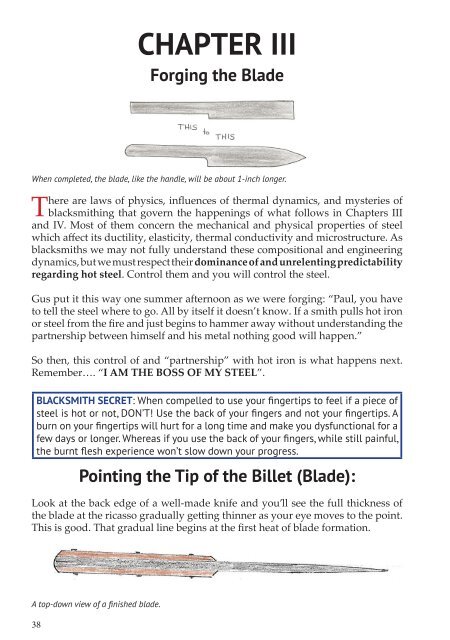FORGED: Making a Knife with Traditional Blacksmith Skills
This book will teach you to hand build a knife using the traditional method of blacksmiths of old — FORGING. Traditional forging of a knife blade is a process which uses the ancient techniques of moving hot steel with hammer and anvil alone into a knife-form that is ready for filing, heat treating and sharpening with no or very minimal electric grinding. This book also teaches traditional fit-and-finish skills using only hand tools. It explains an ancient riveted full-tang handle construction system that surpasses modern methods. In the author's words; "In my early blacksmithing years, I was lucky to get to know some old smiths who wrangled hot iron every day just to make a living. They unselfishly taught me traditional blacksmithing skills and knife forging methods. Every time I use those skills and methods, I honor their friendships, and by teaching you, the reader, we keep alive the memory of those old-time iron pounders." Hardcover, 132 pages, 150 photos and illustrations, $29.95.
This book will teach you to hand build a knife using the traditional method of blacksmiths of old — FORGING.
Traditional forging of a knife blade is a process which uses the ancient techniques of moving hot steel with hammer and anvil alone into a knife-form that is ready for filing, heat treating and sharpening with no or very minimal electric grinding.
This book also teaches traditional fit-and-finish skills using only hand tools. It explains an ancient riveted full-tang handle construction system that surpasses modern methods.
In the author's words; "In my early blacksmithing years, I was lucky to get to know some old smiths who wrangled hot iron every day just to make a living. They unselfishly taught me traditional blacksmithing skills and knife forging methods. Every time I use those skills and methods, I honor their friendships, and by teaching you, the reader, we keep alive the memory of those old-time iron pounders."
Hardcover, 132 pages, 150 photos and illustrations, $29.95.
You also want an ePaper? Increase the reach of your titles
YUMPU automatically turns print PDFs into web optimized ePapers that Google loves.
CHAPTER III<br />
Forging the Blade<br />
When completed, the blade, like the handle, will be about 1-inch longer.<br />
There are laws of physics, influences of thermal dynamics, and mysteries of<br />
blacksmithing that govern the happenings of what follows in Chapters III<br />
and IV. Most of them concern the mechanical and physical properties of steel<br />
which affect its ductility, elasticity, thermal conductivity and microstructure. As<br />
blacksmiths we may not fully understand these compositional and engineering<br />
dynamics, but we must respect their dominance of and unrelenting predictability<br />
regarding hot steel. Control them and you will control the steel.<br />
Gus put it this way one summer afternoon as we were forging: “Paul, you have<br />
to tell the steel where to go. All by itself it doesn’t know. If a smith pulls hot iron<br />
or steel from the fire and just begins to hammer away <strong>with</strong>out understanding the<br />
partnership between himself and his metal nothing good will happen.”<br />
So then, this control of and “partnership” <strong>with</strong> hot iron is what happens next.<br />
Remember…. “I AM THE BOSS OF MY STEEL”.<br />
BLACKSMITH SECRET: When compelled to use your fingertips to feel if a piece of<br />
steel is hot or not, DON’T! Use the back of your fingers and not your fingertips. A<br />
burn on your fingertips will hurt for a long time and make you dysfunctional for a<br />
few days or longer. Whereas if you use the back of your fingers, while still painful,<br />
the burnt flesh experience won’t slow down your progress.<br />
Pointing the Tip of the Billet (Blade):<br />
Look at the back edge of a well-made knife and you’ll see the full thickness of<br />
the blade at the ricasso gradually getting thinner as your eye moves to the point.<br />
This is good. That gradual line begins at the first heat of blade formation.<br />
A top-down view of a finished blade.<br />
38










